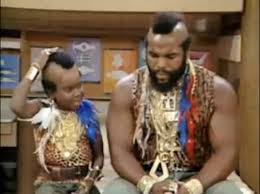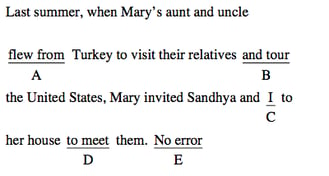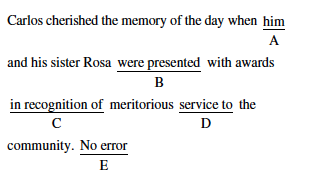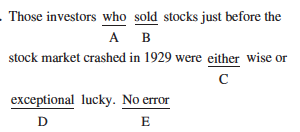 Are you ready for more grammar fun? Pronoun case is a grammar rule that is regularly tested on the SAT. You know the drill: Learn the SAT Writing rule and you'll raise your score.
Are you ready for more grammar fun? Pronoun case is a grammar rule that is regularly tested on the SAT. You know the drill: Learn the SAT Writing rule and you'll raise your score.
In this post, I'll do the following:
- Explain the difference between subjects and objects.
- Give you a clear understanding of pronoun case.
- Offer strategies that can help you correctly answer pronoun case questions.
- Provide you with practice questions so you can test what you've learned.
Quick Review: What's a Pronoun?
A pronoun is a word that takes the place of a noun. The noun to which the pronoun refers is called the antecedent. Some examples of pronouns include I, he, she, it, me, him, her, their, we, and us.
What is Pronoun Case?
Case refers to whether a pronoun is being used as a subject or an object.
What is a Subject?
Simply, a subject is the noun that corresponds with a verb in a sentence. In a sentence where there is an action, the subject is the noun that is doing the action. Here is an example:
Justin writes articles.
Justin is the subject because he does the writing. In a sentence where there is a description, typically using a form of the verb "to be", the subject is the noun that is being described. Consider this possibly accurate sentence:
Justin is odd.
Justin is the subject because he is the person who is odd.

What is an Object?
An object is a noun that receives an action. An object can be a direct object of a verb, an object of a preposition, or an indirect object of a verb. Here is an example sentence with a noun as a direct object of a verb:
I ate an orange.
The object is "an orange" because that is what I ate. Here's an example sentence in which I bolded the object of the preposition:
John spoke to his niece.
John's niece is the object because she is the person to whom he spoke.
An indirect object comes before the direct object and indicates to whom or for whom the action is done and who is receiving the direct object. Here is an example sentence with the indirect object bolded:
I gave my girlfriend a sweatshirt.
In the sentence "my girlfriend" is the indirect object because I gave a sweatshirt to her. The sweatshirt is the direct object because that is what I gave. If you're confused by the concept of an indirect object, for the purpose of pronoun case, just remember that the object receives the action, either directly or indirectly.
Subject Pronouns Vs. Object Pronouns
If a noun is being used as a subject, it can be replaced by a subject pronoun. If a noun is being used as an object, it can be replaced by an object pronoun. Here is a list of subject pronouns:
- I
- You
- He/She/It/One
- Who
-
We
-
You
-
They
-
Who
Here is a list of object pronouns, corresponding to the ones above:
SINGULAR OBJECT PRONOUNS
- Me
- You
- Her/Him/It/One
- Whom
PLURAL OBJECT PRONOUNS
- Us
- You
- Them
- Whom
Now that we've covered all the basics, we are equipped with the necessary knowledge to tackle pronoun case questions on the SAT.
Pronoun Case on the SAT
The SAT tests you on whether you should use a subject pronoun or an object pronoun. You will be tested on the following subject/object pairs:
I Vs. Me
She, He Vs. Her, Him
We Vs. Us
They Vs. Them
Who Vs. Whom
So, now we'll go through the process of how to decide whether to use a subject or an object pronoun in a given sentence.
Strategy
Let's go over some example sentences showing how subject pronouns can replace subjects and object pronouns can replace objects. Check out the following sentence:
Sonia delivered a spectacular speech.
Let's replace "Sonia" with a pronoun. First, we have to determine if Sonia is a subject or an object. Well, because she is the person who did the action, she is the subject. So, we must use a subject pronoun. After replacing "Sonia" with a pronoun, the sentence should read:
She delivered a spectacular speech.
You cannot replace "Sonia" with an object pronoun. You cannot write "Her delivered a spectacular speech." That is an example of a pronoun case error.
Here is another example sentence:
Hillary Clinton gave her autograph to Bob.
Let's go through the same process and replace "Bob" with a pronoun. Is Bob a subject or an object? Well, he follows the preposition "to" and received the autograph from Hillary Clinton. Bob is an object. So, we have to replace Bob with an object pronoun. The resulting sentence should look like this:
Hillary Clinton gave her autograph to him.
If we made a pronoun case error when replacing "Bob" with a pronoun, the sentence would read, "Hillary Clinton gave her autograph to he."

This rule seems relatively simple, right? Subjects do actions. Objects receive actions. Well, we know the SAT likes to complicate the most basic sentences and truly test your understanding of a grammar rule. Pronoun case questions become more difficult in sentences with compound subjects and compound objects.
The Same Rules Apply for Compound Subjects and Compound Objects
Compound just means that two nouns are connected with the word "and". In a sentence with a compound subject, there are two nouns that serve as the subject. In a sentence with compound objects, there are two objects of the same verb. Let's look at an example sentence:
Ice-T and Justin met at an IHOP.
"Ice-T and Justin" are the subject. They are the people who did the meeting. Now, let's replace "Justin" with a pronoun. We know that "Justin" is a subject so we have to use a subject pronoun. Because I am Justin, my sentence would look like this:
Ice-T and I met at an IHOP.
If you were writing this sentence about me, your sentence would look like this:
Ice-T and he met at an IHOP.
That sentence probably sounds awkward to you, but it is grammatically correct. Most people would use the object pronoun and write, "Ice-T and him met at an IHOP." That would be a pronoun case error. Remember, always follow the grammar rules and avoid relying on what "sounds right".
Let's go through the same process with another example sentence:
Mr. T gave gold chains to Marc and Justin.
Again, let's replace "Justin" with a pronoun. Are "Marc and Justin" subjects or objects? Well, they received the gold chains. Also, they follow the preposition "to". They are objects. So, we have to replace "Justin" with an object pronoun. Because I am Justin, this would be my sentence:
Mr. T gave gold chains to Marc and me.
Many students are tempted to write "Marc and I" in this situation. However, in this sentence, that would be a pronoun case error. "I" can only be used as a subject and "me" can only be used as an object.
If you were writing the preceding example sentence about me, you would write:
Mr. T gave gold chains to Marc and him.
Because we are replacing an object with a pronoun, we have to use an object pronoun.

The SAT tends to use compound subjects or objects in questions that test pronoun case because the correct answer often sounds wrong to us. So, can we employ a strategy that allows us to more easily identify pronoun case errors in sentences with compound subjects or objects? Yes!!!
Strategy
If you see a compound subject/object, cross out the other noun and "and". For compound objects, the sentence should still be grammatically correct. Let's do this with the previous example:
Mr. T gave gold chains to Marc and me.
This sentence probably sounds less awkward to you. Most likely, you would be able to immediately identify a pronoun case error if you saw a sentence that read, "Mr. T gave gold chains to I".
If you do the same thing with a compound subject, the sentence will be grammatically correct if you also change the verb from plural to singular, due to subject-verb agreement. However, keep in mind that the singular and plural forms of a verb can be the same.
Let's use the cross-out method with a compound subject to help determine if there is a pronoun case error. Look at the following sentence:
Nathan and him went to college together.
After crossing out the noun and "and", we're left with "him went to college together". Does "him went to college" sound right to you? Probably not.
Regardless, let's rely on the rules. In this sentence, is "him" a subject or an object? It's a subject because they did the action. They went together. Because "him" is an object pronoun, there is a pronoun case error. The sentence should read:
Nathan and he went to college together.
Let's use what we've learned on a real example from the SAT.
Real SAT Writing Example
This is an example taken from an actual SAT. Try to use your newly acquired knowledge of pronoun case and the appropriate strategy to answer this question.

This is an "identify the error" question. Where is the error? Is there an error? Well, let's take a look at answer choice C and determine if "I" is being used correctly. If we use the cross-out strategy we learned to utilize with compound subjects/objects, we're left with "Mary invited I". Perhaps you know the answer at this point.
If not, let's take this a step further. Is "I" being used as a subject or object? Well, in the sentence, "I" is receiving the action. "I" is being invited. Therefore, "I" is being used as an object. That is incorrect. The pronoun "I" can only be used as a subject. The answer is C. The sentence should read, "Mary invited Sandhya and me".
Here's one more example for you:

Is there a pronoun case error in this sentence? Let's look at the phrase "him and his sister Rosa were presented". If we use the cross-out strategy and change the verb from plural to singular, we're left with "him was presented". Would you ever say, "him was presented with an award"? I hope not, because "him" is an object pronoun and it is being used as a subject! In the example sentence, the phrase should be "he and his sister Rosa were presented with awards". The answer is A.
Who Vs. Whom
Occasionally, the SAT will also test you on whether to use "who" or "whom" in a sentence. These words are known as relative pronouns. Most people have no idea when and how to properly use "who" and "whom". Luckily, the rule is pretty simple. The word "who" is a subject pronoun and "whom" is an object pronoun.
Here's a tip to help you more easily answer questions involving "who" or "whom".
Strategy
In terms of pronoun case, "who" and "whom" function like "he" and "him". The word "who" is a subject pronoun and "whom" is an object pronoun. To determine if there is a pronoun case error, replace "who" with "he" and "whom" with "him". If the antecedent is plural, replace "who" with "they" and "whom" with "them".
Here is an example sentence:
Justin, who is my teacher, knows when to use "whom" correctly.
So, the sentence is saying that Justin is my teacher. "Who" modifies Justin, who is being described as my teacher. If we replace "who" with "he", the resulting sentence is grammatically correct: He is my teacher. Therefore, "who" is being properly used as a subject.
Take a look at this sentence:
Justin, whom I adore, writes articles for PrepScholar.
In the sentence, the clause with "whom" is saying that "I adore Justin". If we replace "whom" with "him", the resulting sentence is also grammatically correct: I adore him. The word "whom" is being properly used as an object. It is modifying "Justin", who is receiving the adoration.
Do you get it? Here's one more example:
My friend, to whom I wrote a nasty e-mail, is not talking to me.
Here, the sentence is saying that "I wrote a nasty e-mail to my friend". If we're replacing "my friend" with a pronoun, would we use the subject or object case? Well, since "my friend" follows the preposition "to" and receives the action, you should use the object form. You would write "I wrote a nasty e-mail to him" and not "I wrote a nasty e-mail to he." Therefore, you would also use the object case of the relative pronoun. The word "whom" is being used correctly in the sentence.
Now we can take what we've learned to an actual example from an SAT.
Real SAT Writing Example
Here is an "identify the error" question from a real SAT. Use our strategy and your knowledge of pronoun case to determine if "who" is being used correctly:

In the sentence, "who" is modifying the investors. The antecedent is plural, so with our replacement strategy we should use a plural pronoun. Does the grammatically correct sentence use a subject pronoun? Should it be "They sold stocks"? Or does the grammatically correct sentence use an object pronoun? Should it be "Them sold stocks"?
The answer, of course, is that the sentence requires a subject pronoun. The investors did the selling. Therefore, "who" is being used correctly. Actually, the answer to this question is D. The word "exceptional" should be in the adverb form, "exceptionally".
Now that we have thoroughly investigated pronoun case and the various types of pronoun case questions on the SAT, here are some general strategies to ensure that you correctly answer any pronoun case question you may encounter.
 Almost there!
Almost there!
General SAT Writing Strategies for Pronoun Case
#1: If a Pronoun is Underlined, Check for an Error in Pronoun Case
If a pronoun is underlined in any of the writing subsections (sentence improvement, identify the error, or paragraph improvement), make sure there is not a pronoun case error.
#2: Determine if the Pronoun is Being Used as a Subject or Object
If the pronoun is doing the action or being described, it is a subject. If the pronoun is receiving the action, it is an object. Use subject pronouns for subjects and object pronouns for objects. Use the replacement strategy, if necessary, to help determine if a noun is a subject or object.
#3: The Same Rules Apply for Compound Subjects/Objects
If you see a compound subject/object, the sentence should be grammatically correct if you get rid of one of the nouns and "and". Change "John and I went to the store" to "I went to the store". The sentence is still correct. So, if you see a compound subject/object on the SAT, use the cross out strategy to help determine if there is a pronoun case error. For compound subjects, also make sure that you change the verb from plural to singular.
#4: If a Pronoun Follows a Preposition, It is an Object Pronoun
Pronouns that follow prepositions, specifically "to", "for", or "between", should be in the object case.
#5: Use the Replacement Strategy for Who Vs. Whom
If you are trying to determine whether "who" or "whom" should be used, replace "who" with "he" for singular antecedents and "who" with "they" for plural antecedents. In the spirit of gender equality, you can also replace "who" with "she". The word "whom" should be replaced with "him" for singular antecedents and "them" for plural antecedents. Again, feel free to replace "whom" with "her".
Additional Practice
Hopefully by this point you understand pronoun case and how to correctly answer any pronoun case question that may appear on the SAT. I've created some realistic SAT Writing practice questions to test you on what you've learned. Remember to use the general strategies I referenced above.
What's Next?
Keep honing all the skills you need to do well on SAT Writing. I recommend checking out this article about what's actually tested on SAT Writing. If you're focusing on grammar, read the complete guide to SAT grammar rules.
Those who want to challenge themselves and test their mastery of the SAT Writing section should check out this post about the hardest SAT writing questions.
Want to improve your SAT score by 160 points?
Check out our best-in-class online ACT prep program. We guarantee your money back if you don't improve your ACT score by 4 points or more.
Our program is entirely online, and it customizes what you study to your strengths and weaknesses. If you liked this Writing and grammar lesson, you'll love our program. Along with more detailed lessons, you'll get thousands of practice problems organized by individual skills so you learn most effectively. We'll also give you a step-by-step program to follow so you'll never be confused about what to study next.
Check out our 5-day free trial:
Have friends who also need help with test prep? Share this article!

Justin has extensive experience teaching SAT prep and guiding high school students through the college admissions and selection process. He is firmly committed to improving equity in education and helping students to reach their educational goals. Justin received an athletic scholarship for gymnastics at Stanford University and graduated with a BA in American Studies.


































 Holly R.
Holly R.